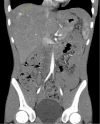Selective Nonoperative Management of a Pediatric Abdominal Gunshot Wound
- PMID: 40636638
- PMCID: PMC12240543
- DOI: 10.7759/cureus.85575
Selective Nonoperative Management of a Pediatric Abdominal Gunshot Wound
Abstract
The standard of care for penetrating abdominal trauma (PAT) has traditionally been exploratory laparotomy. However, significant rates of surgical morbidity and nontherapeutic laparotomies have prompted the development of alternative strategies. Selective nonoperative management (SNOM) is one such approach, which can be considered for hemodynamically stable patients without signs of peritonitis. We present the case of a 17-year-old male patient who sustained a gunshot wound (GSW) to the upper abdomen and right flank. Imaging revealed a grade IV liver laceration with active extravasation. The patient was admitted for serial abdominal exams, hematologic monitoring, and a scheduled computed tomography (CT) angiography in 72 hours. Interventional radiology performed embolization of multiple hepatic artery pseudoaneurysms on hospital day 4 based on the CT angiography findings. The patient was transitioned to a regular diet and was discharged without complication on hospital day 6. This case highlights the safety and efficacy of CT-guided SNOM and delayed angioembolization in pediatric patients with PAT.
Keywords: angioembolization; pediatric trauma care; penetrating abdominal trauma; penetrating liver trauma; selective nonoperative management.
Copyright © 2025, Dodson et al.
Conflict of interest statement
Human subjects: Consent for treatment and open access publication was obtained or waived by all participants in this study. Conflicts of interest: In compliance with the ICMJE uniform disclosure form, all authors declare the following: Payment/services info: All authors have declared that no financial support was received from any organization for the submitted work. Financial relationships: All authors have declared that they have no financial relationships at present or within the previous three years with any organizations that might have an interest in the submitted work. Other relationships: All authors have declared that there are no other relationships or activities that could appear to have influenced the submitted work.
Figures
Similar articles
-
Primary angioembolization in liver trauma: major hepatic necrosis as a severe complication of a minimally invasive treatment-a narrative review.Updates Surg. 2022 Oct;74(5):1511-1519. doi: 10.1007/s13304-022-01372-9. Epub 2022 Sep 4. Updates Surg. 2022. PMID: 36059024 Free PMC article.
-
Penetrating cerebrovascular injuries in a pediatric cohort with intracranial gunshot wounds: incidence, characterization of injury type, and clinical outcomes.J Neurosurg Pediatr. 2025 Apr 18;36(1):65-74. doi: 10.3171/2025.1.PEDS24509. Print 2025 Jul 1. J Neurosurg Pediatr. 2025. PMID: 40250055
-
Signs and symptoms to determine if a patient presenting in primary care or hospital outpatient settings has COVID-19.Cochrane Database Syst Rev. 2022 May 20;5(5):CD013665. doi: 10.1002/14651858.CD013665.pub3. Cochrane Database Syst Rev. 2022. PMID: 35593186 Free PMC article.
-
The Black Book of Psychotropic Dosing and Monitoring.Psychopharmacol Bull. 2024 Jul 8;54(3):8-59. Psychopharmacol Bull. 2024. PMID: 38993656 Free PMC article. Review.
-
Laparoscopy versus laparotomy for the management of penetrating abdominal trauma: A systematic review and meta-analysis.Int J Surg. 2016 Oct;34:127-136. doi: 10.1016/j.ijsu.2016.08.524. Epub 2016 Aug 26. Int J Surg. 2016. PMID: 27575832
References
-
- Marietta M, Burns B. StatPearls [Internet] Treasure Island (FL): StatPearls Publishing; 2025. Penetrating abdominal trauma. - PubMed
-
- Practice management guidelines for selective nonoperative management of penetrating abdominal trauma. Como JJ, Bokhari F, Chiu WC, et al. J Trauma. 2010;68:721–733. - PubMed
-
- Selective nonoperative management of abdominal gunshot wounds from heresy to adoption: a multicenter study of the Research Consortium of New England Centers for Trauma (ReCoNECT) Peponis T, Kasotakis G, Yu J, et al. J Am Coll Surg. 2017;224:1036–1045. - PubMed
Publication types
LinkOut - more resources
Full Text Sources


